Menu
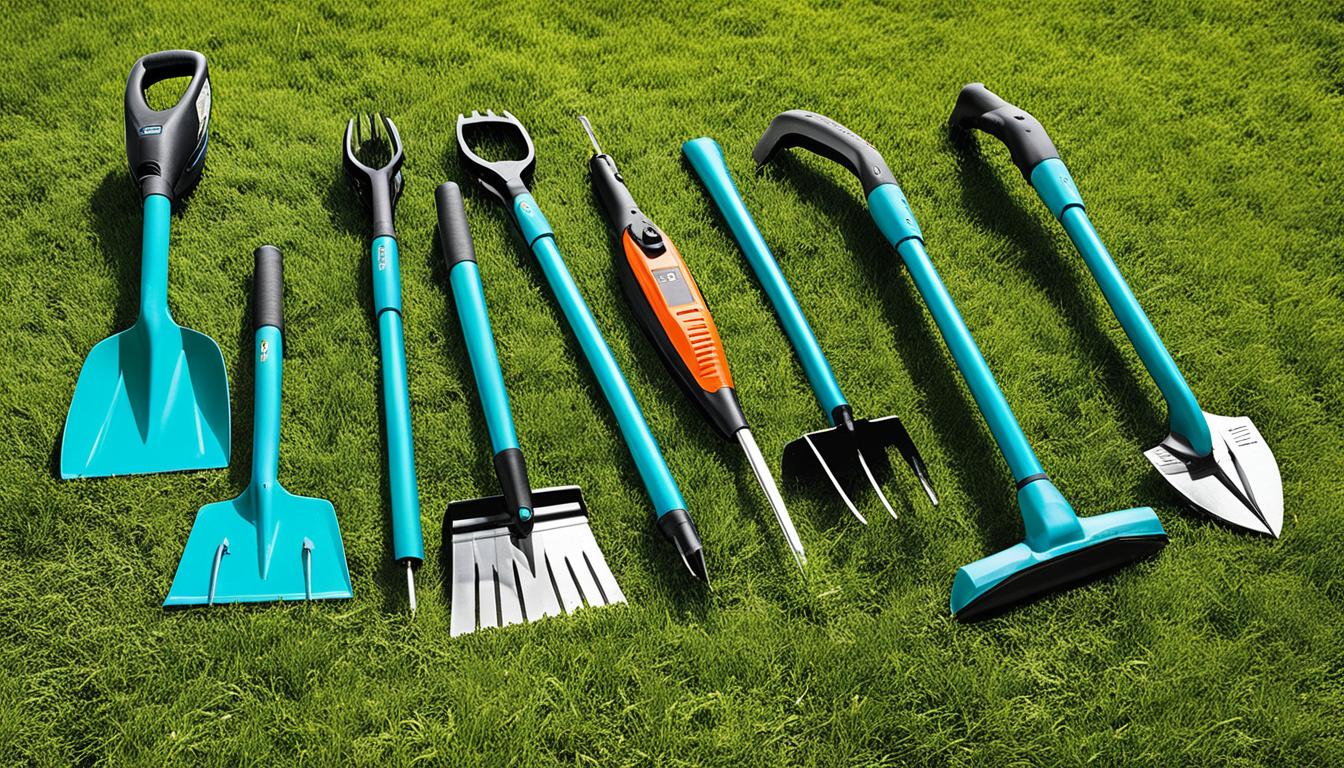
Can the right tools help lower injuries and boost work on the farm? This might sound simple, but it’s vital.
Farming is hard work. It strains the body and can cause injuries. These injuries lead to time off work, which means less income and lower farm productivity. Studying how people interact with their work, called ergonomics, helps prevent these common farm injuries.
By fitting the job to the worker, ergonomics avoids physical stress. Things like bending over, kneeling a lot, and doing the same motion over and over can hurt the back, shoulders, and hands. Changing tools, tasks, or how we position our bodies can cut down on these health risks.
In farming, ergonomics is key. It helps workers do their jobs better while staying safe. Agriculture ranks second for injuries and illnesses. So, using ergonomic farm tools is vital. It boosts work efficiency and keeps farmers healthy.
Farm work often includes repeating tasks. This can cause big health problems. Musculoskeletal disorders (MSDs) are common among farm workers, with back pain as the top issue. Lifting, moving heavy things, and bending a lot can harm the body.
Ergonomic tools match the job to the worker. This lowers health risks. For example, long-handled hoes help with weeding while reducing back strain. Also, tools like extended-handle carriers make lifting plants easier, cutting down on bending and squatting. Using these tools improves health and work efficiency on farms.
Using ergonomic solutions in farming cuts the risk of MSDs. Farm work involves a lot of bending and lifting, which can lead to serious pain and disability. One example is knee problems, which are common among farm workers.
With ergonomic changes, farmers feel less pain. Small tweaks like using smaller tubs for harvesting grapes have made a big difference. Tools like pneumatic cutters also help workers with disabilities. These changes show how important ergonomic farm tools are for keeping farmers healthy and the farm sustainable.
Farmers often get hurt because of the tough work they do. A main issue is musculoskeletal disorders, which lead to back pain, shoulder aches, and sore hands. These problems come from doing the same hard tasks over and over on the farm.
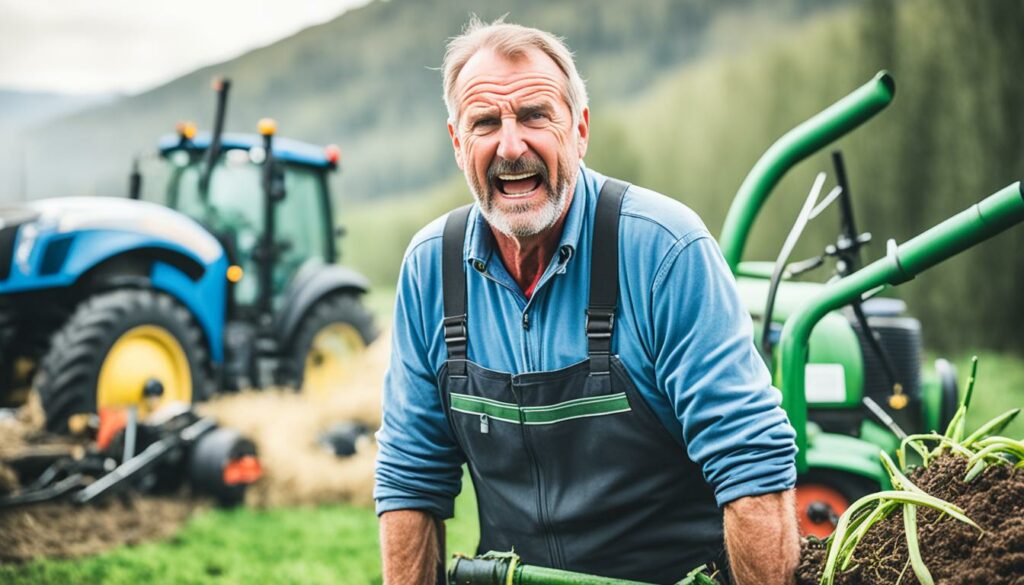
Musculoskeletal disorders can stop a farmer from working. They mostly happen due to tasks like bending, kneeling, and using your hands a lot. In California, over 3,000 back injuries happen on farms every year. This could cost more than $22 million in medical bills and missed work.
Agricultural injuries happen a lot from working in odd positions, lifting heavy things, and feeling the vibrations of machines. Lots of workdays are lost because of pulls and overextensions. That’s why using ergonomic farm tools is really important. These special tools can be designed to avoid these injuries and keep farmers healthy.
Ergonomic farm tools are changing the game in agriculture, mixing comfort with safety. These tools are made to work with the body’s natural moves. This cuts down the physical stress on farmers. This means less injury and a better working space. The National Institute for Occupational Safety and Health says farm workers often suffer from back, arm, shoulder, and hand pain. Ergonomic tools can help avoid or lessen these problems, making farming more comfy.
Focusing on *comfortable farming equipment* is key for the workers’ health. A 2016 study by Ferrante warned about carpal tunnel syndrome from too much gripping. Ergonomic tools help by reducing tough, repeated motions. For example, a lighter tote can make a huge difference, as Meyers et al. found in 2006. They saw 20% less pain with only a 2.5% productivity drop. The AgriSafe Network suggests using floor mats to ease standing fatigue, boosting comfort and safety.
Ergonomic tools also boost *productivity*. They help workers keep good posture and lower how much effort they need to use. This makes the team more alert and energised, lowering the chances of injury. The AgrAbility project helped over 200 people in 2023 with tech support and ergonomic tips. Michigan’s project, helping in 21 states, checks farms for free to improve efficiency. These efforts clearly show that investing in ergonomics can up productivity.
| Health Issue | Ergonomic Solution | Impact |
|---|---|---|
| Backaches | Tote with Handles | 20% Pain Reduction |
| Carpal Tunnel Syndrome | Reduced Gripping Tools | Prevents Chronic Pain |
| Fatigue | Floor Mats | Alleviates Fatigue |
Summing up, using ergonomic farm tools makes a big difference. It keeps workers comfy and safe while boosting *productivity*. These tools can change farming, making it more efficient and lasting.
It’s very important to keep your positioning and accessibility right when doing hand work. Use ergonomic farm tools wisely. Make sure tools you often use are easy to grab. Also, don’t put tools in high places. This way, you avoid bad positions and prevent injuries.
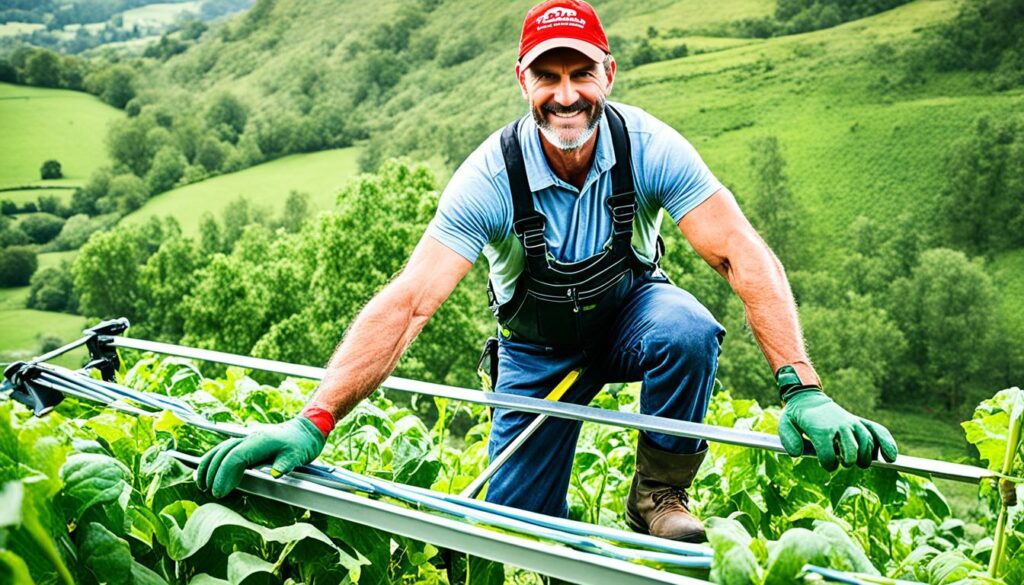
Having the right positioning and accessibility is key. Make sure everything you need is close. Workstations should be at the right height, based on your gender and the type of work. Tools must be easy to get at a height that feels natural. This makes work easier and less tiring.
If you switch between different jobs, you stay safe and comfortable. This keeps your muscles from getting too tired. Also, doing some jobs while sitting can stop your back and legs from hurting. Using ergonomic farm tools in the right way helps you work longer and more easily.
| Ergonomic Feature | Description | Benefit |
|---|---|---|
| Tool Handle Design | Handles should allow the worker to grip all the way around with overlap, covered with smooth, slip-resistant material. | Improves grip and reduces hand strain. |
| Workstation Height | Men: 40″-43″ for light work, 36″-39″ for heavy work; Women: 37″-39″ for light work, 33″-35″ for heavy work. | Prevents back strain and promotes good posture. |
| Task Variety | Alternating between seated and standing tasks. | Reduces repetitive strain and muscle fatigue. |
| Positioning of Tools | Keeping tools within easy reach and below shoulder height. | Minimises awkward postures and improves efficiency. |
Adopting these tips can help farmers work better and safer. Use the right ergonomic farm tools. Follow advice about where to put things. This protects the health of everyone working on the farm.
It’s vital to use ergonomic farm tools, especially hand tools, to cut down physical strain. These days, tools are made to be comfortable. They should fit well in the user’s hand. Let’s explore what to think about when picking ergonomic tools.
Picking the right handle size is key for tool comfort and efficiency. Handles should be 1-3/8″ to 2-1/8″ in diameter. This way, the user’s thumb and forefinger will touch when gripping. It helps avoid hand tiredness and cuts the risk of injuries from repeated movements. Tools must also have a cover that stops slipping to improve the hold.
The material and design are just as important. Tools should be made of smooth, non-slip materials. This makes them gentler on hands and wrists. Modern farm tools may have curved or T-shaped handles. These shapes keep the wrists in a natural position and this lowers the risk of injuries. Some longer tools come with an extra handle. This gives more control and means less bending.
Tools that keep the wrist in a good position and don’t need a lot of force to use make work easier.
| Aspect | Key Points |
|---|---|
| Handle Size | 1-3/8″ to 2-1/8″ diameter, slip-resistant, ensure thumb and forefinger meet |
| Material | Smooth, slip-resistant, comfortable grip |
| Design |
|
It’s key for farm workers to use proper lifting methods. This helps guard against common injuries. Adding ergonomic farm tools and the right equipment lowers the chance of getting hurt. This makes work healthier and more productive. Lifting correctly and using aids are vital steps.
The height you lift things matters for keeping your back safe. It’s best if you lift between your hands and shoulders. This stops you from bending or stretching too much. These moves often lead to back pain. By following these guides, workers can cut down on back and muscle issues. These are major causes of lost work time.
Efficient tools like container handles and carts help a lot. They make it easier to lift by spreading out the weight. With these tools, farmers can lift things right. It means they’re less likely to get hurt. For example, using containers with good handles means you’re less likely to drop them. Carts are great for moving heavy stuff without straining. These tools are a big help in stopping work injuries.
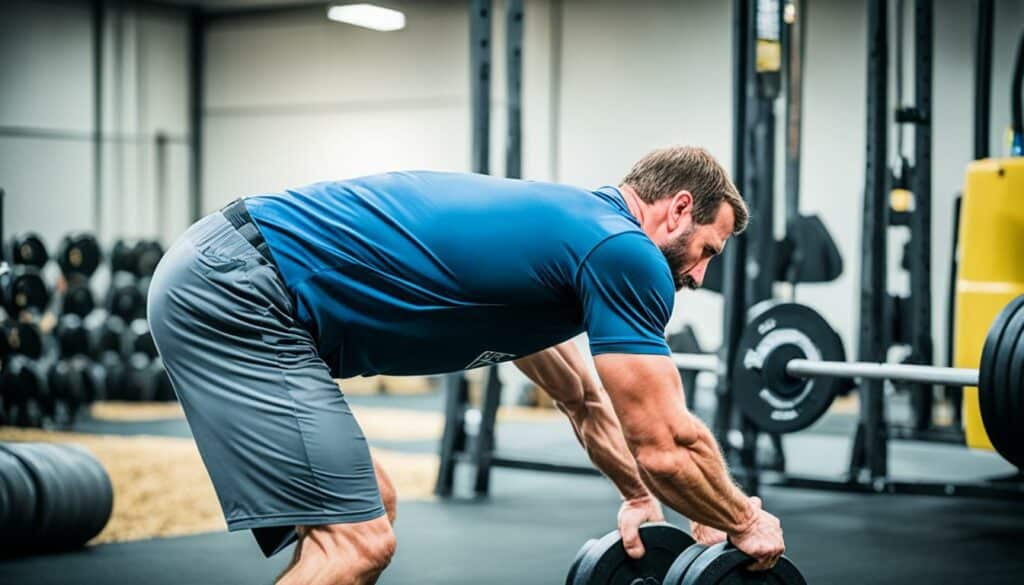
In California agriculture alone, the yearly cost for backing injuries is huge. It could be over $22 million. This shows how crucial it is to lift the right way.
By lifting properly and using the right farm tools, injuries are reduced. Farm work becomes safer and more efficient. These steps promote better and more sustainable farming. They protect the health and work rate of farm workers.
Designing workstations that are ergonomically designed is key for boosting farm output and keeping workers healthy. The National Institute for Occupational Safety and Health (2001) notes that farm workers often suffer from backaches and arm pain. These issues can harm a farm’s success over time. Using floor mats can help ease fatigue from standing on hard surfaces for long.
To make farm tools easy to use, place them at a height that’s between your knee and shoulder. This tip comes from the National Institute for Occupational Safety and Health (2001). It should be so tools are just 17 inches away, which makes reaching for them easy. Ferrante (2016) points out that well-designed tools can stop hand pain from tasks that need a lot of gripping.
Farm tools that are ergonomically made can cut down on doing the same movements again and again. Meyers et al. (2006) discovered that reducing how much farmers carry by 11 pounds and using handles on totes can drop pain and symptoms by a fifth. This change only causes a small 2.5% drop in how much work gets done. Their research shows how important smart tool and workstation design is for keeping farmers healthy.
If workstations can be changed to let people work sitting, standing, or walking, it helps everyone to find what suits them best. This can make working on a farm more comfortable and efficient. Groups like AgrAbility, helping over 200 people in 2023, suggest tools and ways to work that fit the needs of those with disabilities. They push for making work setups that can change as needed to help all workers do their best.
Following these tips, farms can make ergonomically designed workstations. Doing this makes farms safer and more productive. It’s a win-win, helping both the workers and the farm’s success.
Stooped work in farming leads to many muscle and joint issues. We can lessen these risks by using the right tools. Also, small changes in how we farm can help a lot.

Adapting tools can make stoop work less harmful. Tools with long handles are great because they reduce bending. They also cut down on needing to stoop often.
Handles that are 1-3/8” to 2-1/8” in size make tools easier to hold. They cut down on hand soreness. Adding material that stops slipping helps keep a good grip. This means less tired hands.
Doing different jobs during the day can lower injury risk. It stops the body from being under the same stress over a long time. Adding seats to work areas also helps because sitting is better for your back and legs than standing.
This also lets workers easily switch between standing and sitting. This change can stop muscle and joint problems.
| Injury Statistics | Details |
|---|---|
| Common Pains | Backaches, shoulder, arm, and hand pains |
| High-Risk Tasks | Tasks with high force or awkward positions, especially if frequent |
| Optimal Workstation Heights | Men: 40”-43” (light work), 36”-39” (heavy work); Women: 37”-39” (light work), 33”-35” (heavy work) |
| Handle Specifications | Diameter: 1-3/8” to 2-1/8”, average 1-3/4”; Slip-resistant material; Dual-handled length: at least 4” |
| Load Lifting Guidelines | Between hand and shoulder level; Handles on containers |
| Stooped Work Strategies | Redesign jobs, use long-handles, provide stools |
Using the right tools and changing work tasks keeps farm workers safe. This also boosts their morale and how much they get done. By following these steps, farming becomes both safer and more efficient.
Farm work can be tough on the body, leading to muscle and joint problems. One issue is the jolts felt when using farm vehicles. To tackle this, we need to add comfy, safe features to these machines.
Vibration-damping seats are a big help. They reduce the shocks the worker feels. This means that with techy seats, the job feels less bumpy and more comfy.
It’s not just about fancy seats. Where these seats are placed is also key. They should be set up to support the lower back well. This stops back pain. Each seat should be set to match the user’s size, making it easy to reach all the vehicle’s controls without any extra effort.
For more tips on ergonomics, check out ergonomic vehicle solutions.
With these tweaks, farm workers can cut down on injuries and enjoy a better work setup. These ergonomic features help boost work quality while keeping the worker healthy.
New advanced farm tools help make work easier and keep workers safe. They help reduce sprains, strains, and back injuries on farms. California’s agriculture sector alone spends over $22 million each year on more than 3,000 back injury claims. Tools like weeding stands and harvest carts cut the chance of injury and boost how much work gets done on the farm.
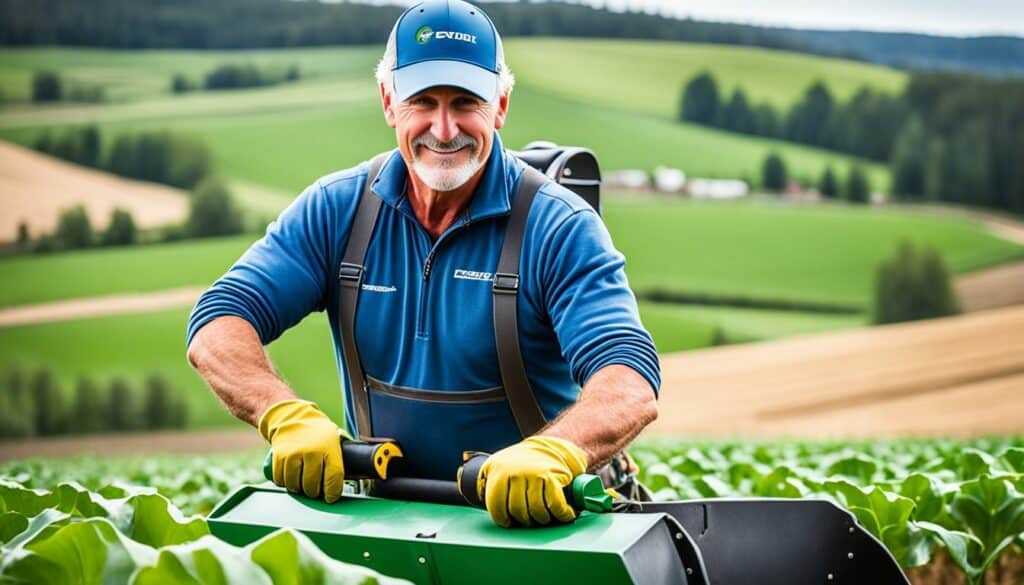
Weeding stands lessen the hard work of pulling weeds. They keep plants at a good height and angle so workers don’t have to bend and stretch a lot. This reduces injuries that come from too much bending. Harvest carts make moving crops easier too. They take away the need for heavy lifting and lessens the chances of getting hurt.
Special lifting tools are key in making farm work safer. They suggest keeping lifts between hand and shoulder level. It’s also better to have handles on containers for safety and easier moving. These tools are made to stop the muscle and joint injuries that often slow workers down. With these tools, farmers can move things easily without risking injury.
The new farm tools are a big step in preventing muscle and joint problems. Tools like weeding stands and lifting help keep farmers safe and working well. This makes farming a better and healthier job for everyone.
Ergonomically designed garden tools are changing the game for gardeners and farmers. They cut down on physical strain. These tools are made to help keep joints, backs, and wrists from getting sore. This makes working in the garden easier and more enjoyable.
Long-handled tools are now a must-have for those who need to avoid bending and kneeling a lot. They let you garden standing up. This reduces the chances of hurting your back or getting tired too quickly. A good example is the Fiskars 4-Claw Weeder. It has a long, 34-inch handle so you don’t have to bend too much. Tools like the Peta Easi-Grip Set also have special grips. These grips are shaped to be kind to your hands and help you hold the tools easily.
Lightweight gear makes gardening easier. Tools like the Radius Garden Ergonomic Transplanter weigh less than eight ounces. This means you can keep working without feeling worn out. The Bionic ReliefGrip Gardening Gloves make work more comfy too. They have special pads and tips to give you a better hold. The Dramm One Touch Rain Wand makes watering simple. Its lightweight aluminium body and easy valve give you more control.
Gardening tools have seen major upgrades. Cushioned handles and extendable parts have made them safer and nicer to use. You can find these upgraded tools online. This gives gardeners lots of choices to make their gardening experience better.
Buying top-notch ergonomic farming tools is key for a safer, more effective farm. In California alone, farming sees more than 3,000 back injuries every year. The costs can go over $22 million in workers’ compensation. The right tools can really cut down these troubles.
Ergonomic farm tools lessen the strain on those who work the land. They use top-quality materials and smart design to keep the user comfy. This cuts down on injuries like back pain, sore shoulders, and aching hands. The workers feel better, and the farm runs smoother.
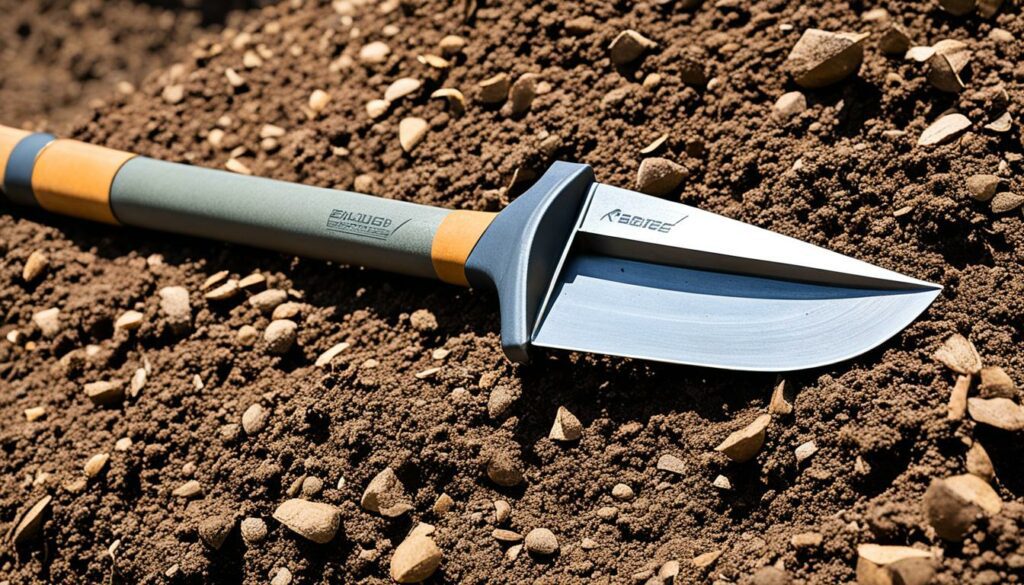
Many farm injuries happen because of constant heavy lifting and awkward movements. But, new ergonomic tools tackle these issues, making the farm a safer place. Even small changes to tools can make a big difference in preventing common farm injuries.
The best ergonomic tools are built to last and work well. They offer things like weeding stands that are easy on your body and special lifting gear. These tools help farmers stay healthy and do their jobs better for the long run.
Introducing ergonomic practices can greatly reduce injuries on farms. By looking at what workers do and their needs, we can make tools and ways of working better. This makes work safer and more efficient.
One good idea is to have teams of workers and managers focus on ergonomics. They come up with smart, simple solutions for each job on the farm. This way, everyone helps choose tools that are easy to use and protect from harm.
Studies show that using the right tools can help farm workers. Backaches and arm pains, common in farming, can be eased by designing tools well. For example, making loads lighter and using totes with handles cuts down pain without much work lost. So, minor changes in how tools are made can really help.
It’s also key to use tools that don’t strain the hands too much. They help avoid problems like carpal tunnel syndrome, as Ferrante (2016) points out. Tools should not tire the wrists and hands too quickly.
Ergonomic tools can help in ways we might not realise. For example, using special floor mats cuts down on tiredness from standing on hard ground. This shows how making small changes can help workers feel better. Also, programs like AgrAbility have helped many farmers with disabilities find the right tools.
In fact, many farm injuries are caused by sprains and strains, according to data. These can lead to severe disabilities. By adjusting tools and work ways, we can prevent many of these injuries. Making tools fit workers better is crucial for their safety.
Choosing to focus on ergonomics can make farms safer and more successful in the long run. This helps both the people working on the farm and the farm’s success over time.
Ergonomic farm tools and practices are key to reducing injuries among farmers and boosting their well-being. With agriculture as a top sector for injuries and illnesses, this is crucial. Rosecrance et al. (2006) showed that farmers often suffer from low back pain and musculoskeletal issues, with percentages from 7% to 33%. These issues, mainly low back pain, are common in agriculture.
Studies by Hartman et al. (2006) and Nieradko-Iwanicka (2019) prove that ergonomic solutions help. They point out risk factors and the need for ergonomic action. Anker et al. (2008) also found links between posture, weight distribution, and the importance of ergonomic improvements.
Hoogendoorn et al. (2000) and Coenen et al. (2013) have shown that small ergonomic changes reduce pain and enhance posture. These methods, along with new technologies, help prevent injuries. Research by Zambon et al. (2018) highlights the high rate of job accidents in farming, pushing for better tools and practices.
Ergonomic solutions are not just helpful, they are necessary. They can lower injuries and improve work. This better connection between the worker and their tools is vital for a thriving agricultural sector. As farming changes, pushing for ergonomic awareness and use is crucial for the success of farmers and their work.
Ergonomic farm tools are designed to make farm work easier on the body. They encourage better posture and lessen the need for repetitive actions. This helps to reduce injuries like backaches, shoulder pain, and hand strain that farmers often face.
Ergonomics makes tools and work areas fit better with the human body. This cuts down on physical stress for farmers. It lowers the chances of injuries and muscle issues, boosting how much work can be done comfortably and efficiently.
Backaches, shoulder pain, and hand discomfort are frequently seen among farmers. These problems come from doing the same heavy, hard tasks over and over. Things like stooping, kneeling, and lifting heavy loads cause these issues.
The top causes of getting hurt in farming are straining posture, carrying heavy items wrongly, and doing a lot of kneeling work. The vibrations from farm machines can also hurt the body. All of these can lead to various physical injuries.
Using ergonomic farm tools helps in many ways. They make work more comfortable, increase safety, and boost productivity. These tools lessen the physical toll, prevent injuries, and allow farmers to get more done the right way.
The main tips for hand work in farming include having tools close to the body and not too high. This stops the need to bend or reach too much, which can hurt the back. Also, mixing up tasks can help avoid straining the same muscles over and over.
Pick a handle that fits well in your hand and allows the forefinger and thumb to touch slightly. The handle should be easy to hold, not slippery, and comfy. This makes using the tool easier on your hands.
Good lifting methods keep the strain off your back. Lift between your waist and shoulder whenever you can. Use handles or lifting aids for heavy items. Remember to keep your back straight to avoid injury.
Ergonomic workspaces should fit the job, promote different types of movement, and have space for comfortable sitting. They should also be the right height and use mats to lessen the tiredness of standing for long.
Making tools with longer handles can make stooping tasks less hard. Mixing up jobs can also help avoid working bent over too long. Employers can help by updating tasks and using tools that are easier on the body.
For vehicles, fitting them with seats that lower vibrations and support your back is key. This reduces the impact of rough rides. It makes driving or riding farm vehicles less tiring and harmful to your body.
Weeding stands and harvest carts are examples of advanced tools for farming. Weeding stands make reaching plants easier, cutting down on bending. Harvest carts make transporting crops less taxing by reducing heavy lifting.
Garden tools with long handles and that are lightweight make gardening easier on the body. They reduce the need to bend and lift heavy items, making work more comfortable and less risky for injury.
Top-quality ergonomic tools are important as they are made with user comfort in mind. They lessen the physical strain on farmers and last longer. This makes farm work easier, supports good health, and improves how efficiently farms run.
To use ergonomics well, farm owners and workers should work together. They need to match tools and tasks to the worker, and encourage ergonomic teams. By sharing ideas and being creative, farms can operate in a way that’s kind on the body.